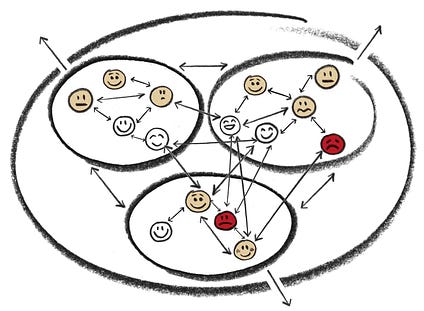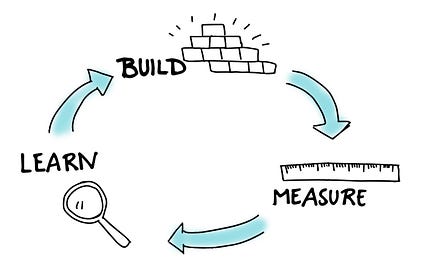A few days ago, startup CTO Peter Vukovic tweeted the following “quote”:

— no company ever said.
Reading this reminded me of a thought that was often top of mind when I led engineering teams. How come OKRs are so pervasive while, in the vast majority of cases, they work so poorly?
Thanks for reading The Weekly Hagakure! Subscribe for free to receive new posts and support my work.
To try and find some answers other than my own, I tweeted out the following question:


“We owe our success to meticulously planned OKRs.”
— no company ever said.
The many replies pretty much confirmed my sense that something is off in OKR-land:
-
Orgs don’t have the right leadership, and investors push them to use OKRs.
-
A passive-agressive management tactic deployed by conflict-averse executives.
-
A lightweight goal framework expected to make up for other systemic failings.
-
Too much leadership, too little management, left to consultants/OKR coaches.
-
New execs ushering in OKRs to take credit for any success that happens.
-
Lack of commitment to giving the necessary context behind the objectives.
-
Too vague at the top, too unrelated to concrete needs on the ground.
-
An evolved ceremony that makes everyone feel like they did something useful.
-
They end up being used as task lists.
All of these speak more to a failure of usage rather than a poor system per se. The same can be said for “Agile”, or most other frameworks du jour. As someone once said, blaming the OKR process for not achieving your goals is like blaming oxygen for forest fires.
But the reply I found really interesting, which I feel gets to the heart of the matter, is this one from Philipp Mohering:

It’s hard to reject them as one will always come across as the irresponsible person in the conversation vs the rationalist.
Ah, the good old illusion of control. Let’s dig a bit into that, shall we?
What Job Are OKRs Doing?
Well, depends on who you ask.
Ask anyone on the front lines if they’d voluntarily sign up for OKRs and I suspect the percentage who would say ‘yes’ is in the low single-digits. And out of those, a significant portion will probably claim it’s “good for personal development plans”—which I agree with, by the way.
As for middle managers, the poor folks are usually torn between a chance to shine in OKR review meetings or finding a way to justify yet again why their team’s OKR is “red”. In between, a whole lot of grunt work, herding cats, and the like. All things considered, most middle managers are not big fans either.
By now, it seems obvious that senior leaders—founders, CEOs, executive teams—are the biggest “customers” of OKRs. If we use the Jobs-To-Be-Done (JTBD) framework as a lens for this, we can ask the following question:
What job are senior leaders hiring OKRs to do?
The book Measure What Matters by venture capital icon John Doerr is a good place to look for answers to that question. Doerr was, after all, the man who ushered OKRs into Google to great effect.
Two quotes from him pretty much summarize the book (emphasis mine):
“Ideas are easy. Execution is everything. It takes a team to win. More than that, it takes a team to achieve objectives and key results.”
“The most successful companies in the world are great at execution. And that’s where OKRs come in – by helping teams execute better, faster and more effectively.”
Execution, execution, execution. Music to any founder and/or CEO’s ears, right?
Right. But wrong, too.
The execution obsession hides a glaring and common deficiency regarding what we’re executing on. It is often predicated on the idea that “we already know what we should build” (one of the hallmarks of the feature factory). But the sad reality is that any startup who has not yet clearly achieved product-market fit does not, by definition, know yet what they’re doing.
Unless what they’re doing is learning and learning effectively.
That’s not, however, what OKRs incentivize. Instead, with the goal of “focusing” and “aligning” teams towards the company goals, they tend to stifle exploration, reinforce organizational silos, generate hard-to-resolve conflicts between teams, and generally make folks myopic and feeling like they’re a small cog in the machine.
All in the name of execution.
A Complex Disconnection
Here’s an idea that’s been bouncing around my brain like a pinball for a couple of years now.
Writ large, the way the VC-backed startup game works is venture capitalists investing money into multiple startups (their “portfolio”) and expecting a multiple of their investment in return. For that to happen, the businesses obviously need to grow in value—the more, the faster, the better. Those who take the money are then beholden, in a significant way, to their investors: there’s a commitment, usually codified as certain targets in a budget, with associated forecasts, some of which often finds its way to the company-level OKRs (e.g. grow revenue by X, grow # of MAU by Y, etc).
Unsurprisingly, when you’re beholden to a number, you want as much predictability as possible so that you’re able to sleep at night. You want to “ensure” you achieve your targets. You crave control.
And what do you have as a means to achieve those results?
Yep. Nothing more than a bunch of humans, all quirky, each one a beautiful snowflake with their own story, issues, hopes and ambitions. Each one with their own life experience, cultural background, childhood traumas, mental models and cognitive biases.
In other words, what you have to work with is a complex system.
Two things complex systems don’t respond well (or at all) to? Predictability and control. Why? Several reasons:
-
Non-linearity. Small changes can have large and unpredictable effects. You don’t really know how the system will behave in response to changes or interventions.
-
Emergence. Complex systems often give rise to emergent behavior or patterns, highly dynamic and changing over time, that are difficult to predict based on the behavior of individual agents or components.
-
Feedback loops. The output of the system often feeds back into the input, creating a self-reinforcing cycle that makes it difficult to predict how changes to the system will affect its behavior in the long run.
-
Interconnectedness. Many agents or components influencing each other’s behavior in complex and unpredictable ways. This can make it difficult to isolate the effects of individual changes or interventions.
-
Uncertainty. Both in terms of the behavior of individual agents or components and the behavior of the system as a whole.
Oops.
To recap, senior leadership needs predictability which drives a desire for control in order to achieve the required results. But that control is inevitably exerted over a complex system, which is not only not amenable to it but is also largely unpredictable.
And most of this is predicated on the idea that “all we have to do is execute.” Hence, focus and alignment—a well-oiled machine—is what matters. And, sure enough, we measure what matters.
But is that, really, what product discovery and development is about?
Execute To Learn, Learn To Execute
“The only sustainable competitive advantage is an organization’s ability to learn faster than the competition.” — Peter Senge
I’m putting myself on the hook here by arguing that execution is not the only game in town. I want to be clear: as Thomas Edison said, “Vision without execution is hallucination”. True. But it’s also true that, as Peter Drucker pointed out, “There is nothing so useless as doing efficiently that which should not be done at all.”
My point is not that execution doesn’t matter—it’s that it’s not the only thing that matters. Unless you already hit gold, the most important job to be done is to learn. The ability to execute must therefore be in the service of learning as fast and as well as possible, rather than to execute on brilliant, unvalidated ideas. The same is true about learning how to better function as a team, and as an organization.
As I hope to develop further in future posts, this execution obsession, what I like to call the “productivity mindtrap”, is a startup killer. It has real costs, both financial and, most importantly, human. It engenders a rat race that is not only misguided, but unecessary.
What is needed is exploration, discovery, creativity, collaboration, elevation… all things human beings are particularly good at, should they be enabled to do so. Instead, mired in survivorship bias, we insist in copying and pasting frameworks that worked in a handful of places, conveniently disregarding the vast majority peacefully lying six feet under in the startup graveyard—who also, by the way, swore by OKRs.
It doesn’t have to be that way. There’s other possibilities, less aligned with the metaphor of the machine, and more in line with how nature works—more creative, more evolving, more adaptive.
I should note that my only intention with this week’s post is to create a bit more awareness about what I consider to be a major disconnect, a fault line inside organizations that leads to a lot of pain, heart ache, and missed business results. This naturally leads to many questions, such as:
-
“If not OKRs, then what?”
-
“How do we bridge the disconnect you talk about?”
-
“What can I do in my team/company?”
None of these have easy answers, but it’s the exploration that is worthwhile. I intend to use future posts to continue poking at the edges of our current narrative, and explore how malleable they really are. Until then, as far as OKRs are concerned, I recommend this post by John Cutler to perhaps whet your appetite for other “types of food”.
Thanks for reading. If you enjoyed this post, please consider hitting the ❤️ button, and sharing it using the button below.
Also — I have a couple of openings for executive and leadership coaching. If you’d like to explore working with me, drop me a message on LinkedIn or Twitter.
Until next week, have a good one! 🙏




